With integrated pest management (IPM), monitoring crops and correctly identifying pests demands well-trained experts. Choosing one treatment over another is based on a set of factors that include the pest’s identity, the size of the pest population, the pest maturity stage, and the environment. If treatment is to be applied, it should be scheduled to make the most economic sense. Whether you are an agronomist, farmer, or gardener, tracking the growing degree days (GDD), also known as growing degree units, can take your plant protection skills to a new level. Luckily this operation, which is considered cumbersome, and requires phenology modeling understanding, is becoming very simple with the growing degree days app we offer. Agrio acts as a growing degree days calculator and makes your life easier.
What are growing degree days?
GDD is a measure used to calculate the amount of heat required for the development of organisms (such as insects) in each stage of their growth. GDD is used to predict insects’ migration, egg hatching, fungal spore development, sexual maturity, and more. Operations that aim to reduce the population density of a pest need to coincide with the high presence of the most susceptible life stage of the species in the field. With insects, GDD can help us time the vulnerable stages of certain insects, such as the hatching of eggs of a particular pest. Compared with using the calendar method to estimate the organism stage, GDD is a more accurate method.
Each organism may require a different amount of accumulated heat to develop from one life stage to another. Phenology models are being developed and tested in laboratories and field experiments to provide accurate life cycle predictions. However, such procedures are expensive to conduct, and therefore the phenology models of many organisms are not readily available. Large-scale observations made by growers worldwide and reported on the Agrio platform is an easy way that allows the development and update of such models.
Combining a weather forecast with a rigid phonology model brings a new level of sophistication to pests, diseases, and weeds management.
Growing degree days formula, growing degree days base temperature, and development thresholds
Phonology models predict the effect of temperature on the growth and development of biological organisms. Experiments show that there is a range of temperatures in which development is possible. The lower and upper developmental thresholds are usually used. When the temperature is below the lower developmental threshold (growing degree days base temperature), the organism is not expected to develop further. The upper developmental threshold is generally regarded as the temperature at which the growth rate starts to decrease. The growing degree days base temperature and upper threshold are determined through experiments and are unique to a specific organism.
Set the biofix to initialize the GDD calculator
The accumulation of growing degree days starts at the biofix (biological fix) date. The biofix can be a biological event or a calendar date that makes the organism’s survival possible. In case of a biological event, growers must scout their fields to time the event’s occurrence. In some cases, trap installation and frequent examinations of the traps are needed to set the biofix accurately.
In many situations, the biofix is set based on the development stage of the plant. Satellite monitoring and weather models help us to forecast the plant stages for you. We send detailed information regarding scouting recommendations in every stage of the growth.
Area-wide Integrated Pest Management
Once precise methods are followed to decide on treatment schedules, there are vast options that become possible. One of the exciting possibilities is the alignment of treatment schedules in different farms and gardens. Communities of growers can consider the practice of Area-wide integrated pest management, which is the paradigm in which pest control decisions and timing are coordinated in many fields occupying a wide area. This approach is especially practical for mobile pests as it provides better control of pests in broad areas by eliminating the pest migration between fields.
Growing degree days calculator and growing degree days app
Agrio makes precise hyper-local weather forecasts readily available to all growers. These state-of-the-art weather prediction models provide our growers an hourly hyper-local weather forecast designated specifically to their unique area anywhere in the world; the forecast is provided at a 3km resolution, so it is specific to their fields and gardens.
There is no need to check the growing degree days accumulation based on your zip code. We help growers abandon cumbersome excel sheets and complicated growing degree days formulas and instead rely on our algorithms to do the GDD tracking for them. We compute the accumulation of the growing degree days based on hourly temperatures instead of the more common practice of averaging the day low and high temperatures. This guarantees more accurate results. We manage the entire process for the grower in the following way:
- The home screen’s daily briefing instructs growers on the required scouting operations and interventions in their fields. These are updated in real-time with the progress of the growing degree days accumulation, observations in the field made by the grower, and observations made by the community members in relevant proximity.
- Agrio instructs growers when and how to set the biofixes promptly. We provide elaborate information on trap installation and maintenance as well.
- Agrio tracks GDD according to multiple phonology models corresponding to different pests, diseases, and weeds in different fields or gardens that a grower manages.
- We use big-data to optimize our predictions and offer phenology models particular to the different locations. We validate our phenology models continuously and adjust them when and where it is needed.
- We coordinate area-wide integrated pest management operations and present users with the optimal IPM treatment on time.
The codling moth growing degree days calculator and model
To demonstrate how this technology can help growers, we want to discuss the tracking of growing degree days for a specific example. We will discuss the management of the codling moth in apple orchards.
Codling moth larvae are one of the most destructive pests. Although it can attack various fruits, it mainly damages apples. This is the primary pest of apples and needs to be managed in each orchard.
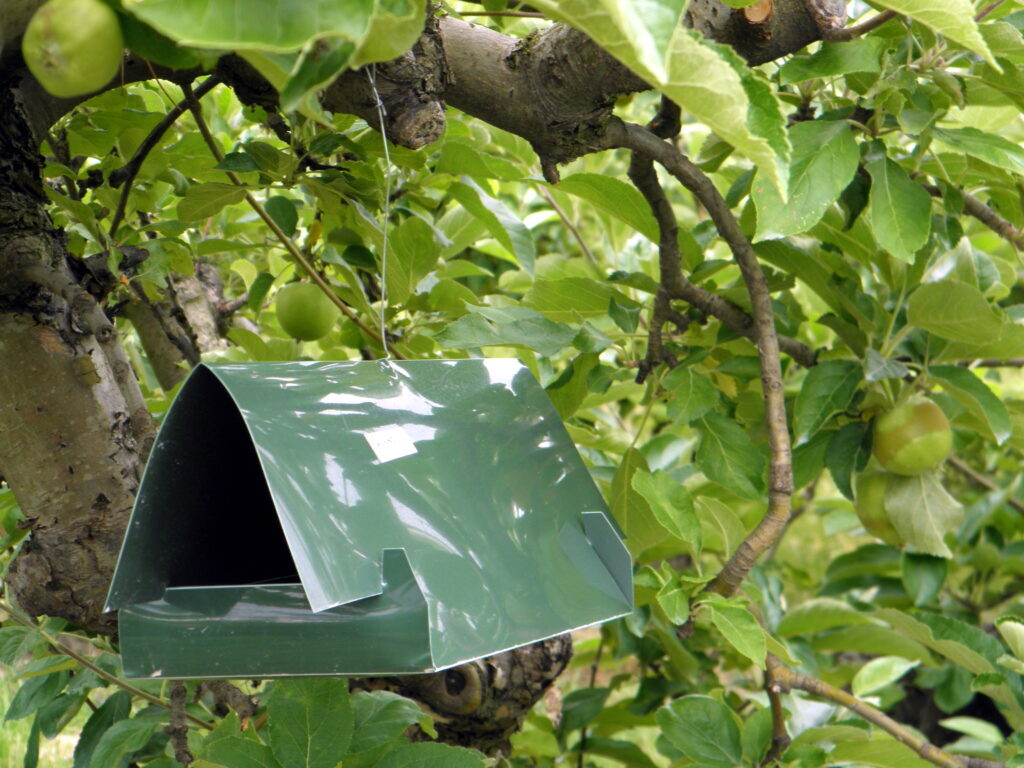
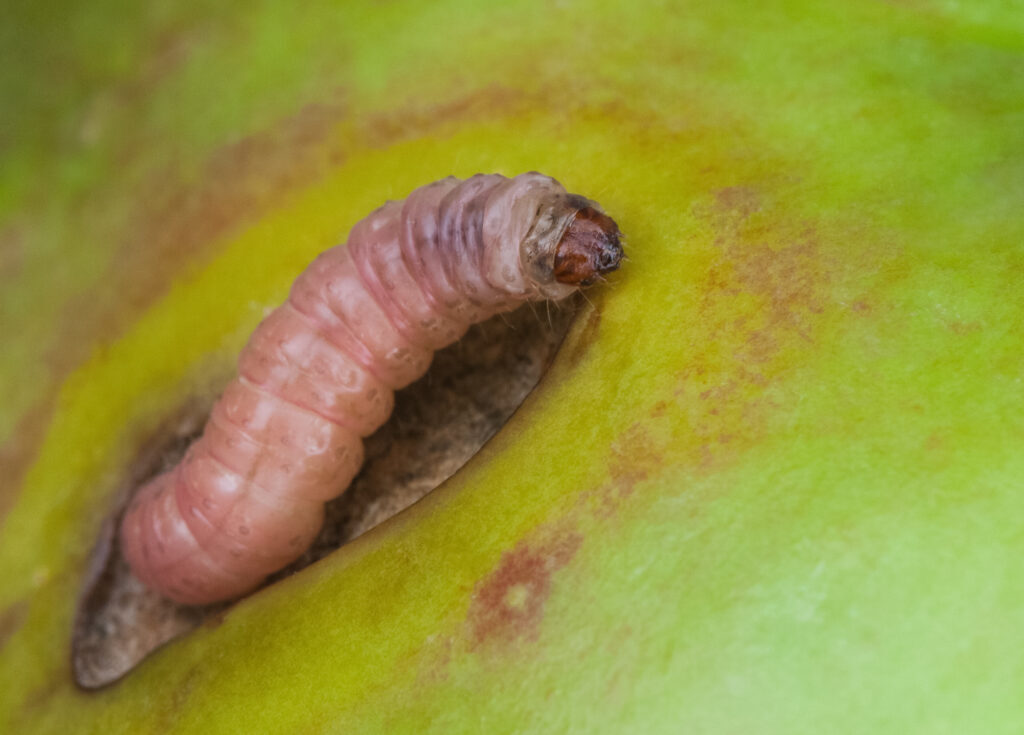
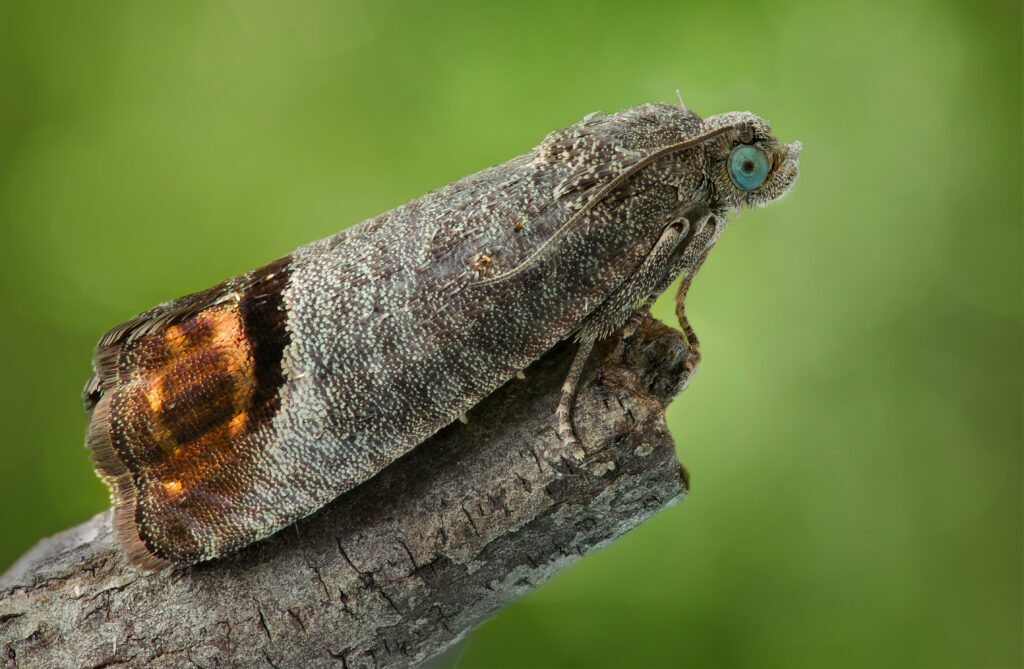
To monitor the presence of adults in the orchard, growers need to install pheromone traps. The trap’s purpose is to attract male moths, and they should be installed before the pink stage of apple bud development. The trap’s inner surface is coated with a sticky material to hold insects when they fall into the trap. Traps should be checked by growers every day, and the trapped moths should be counted in each area separately. A total of five moths captured in the trap is the threshold to set the biofix; this is the day on which growing degree days will start to be tracked by the app. The accumulation of growing degree days is used to predict when egg hatching will occur and when pesticide application will be most effective.
Before the pink stage of the apple buds development, Agrio notifies growers that pheromone traps should be installed. The information page provides all the required instructions for the installation. In addition, the information page instructs the grower on what requirements need to be satisfied to set the biofix.
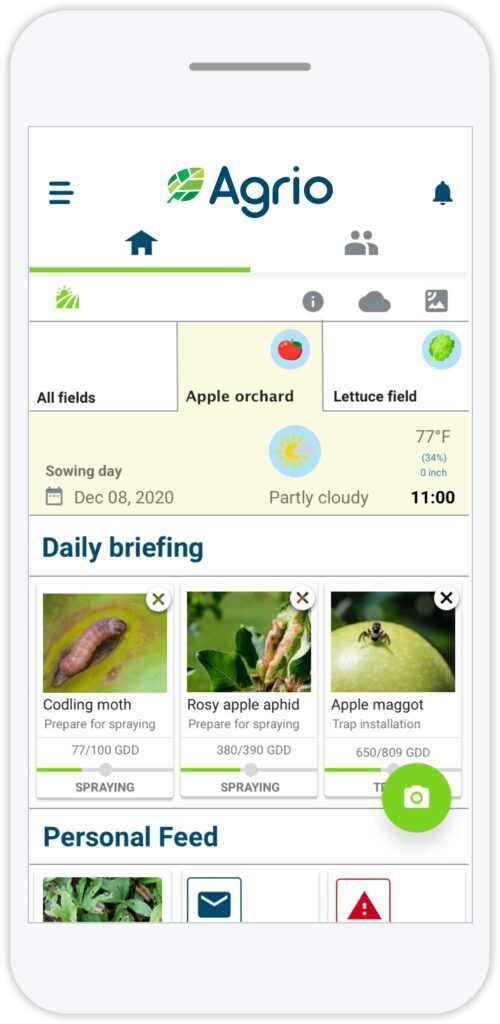
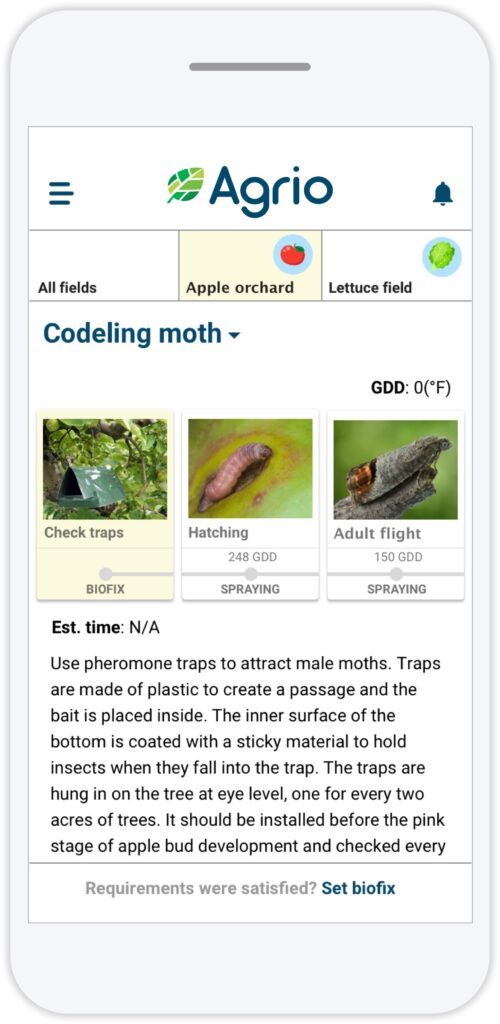
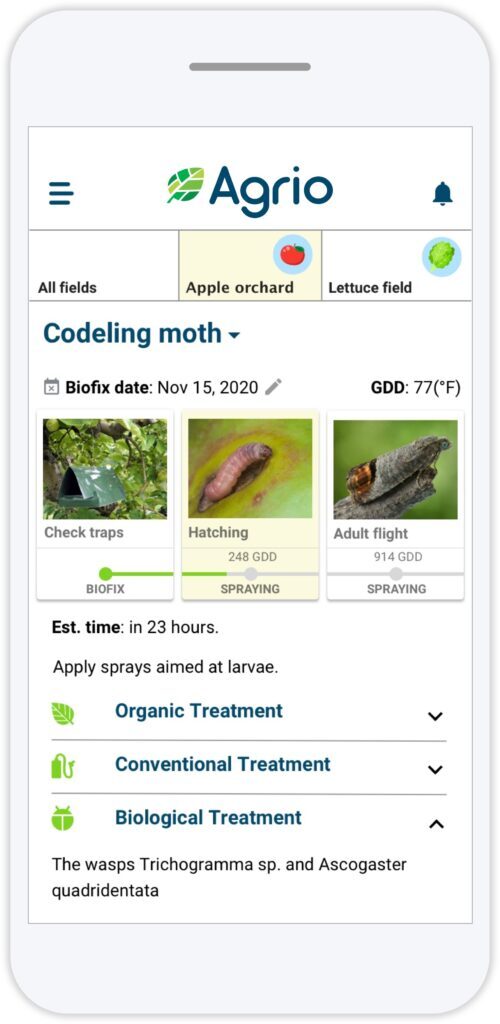
Once the biofix is set, Agrio starts to track the GDD and shows an estimation of the time until the next spraying is due; growers should stay tuned and follow the instructions in the daily briefing section on the app. Notifications are sent as a reminder when important events are near. Growers can use our image identification capabilities if help is needed with the trap analysis, as precise moth identification can be challenging. The aim is to spray when the eggs are hatching; this is when growers will be notified with information on the required intervention.
The colorado potato beetle growing degree days calculator and model
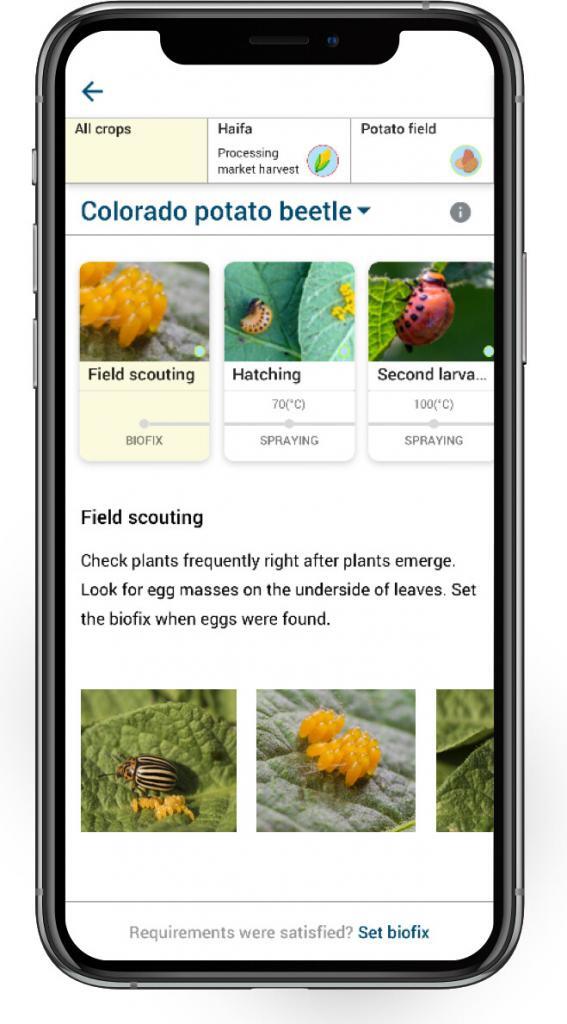
The Colorado potato beetle is a pest that can destroy potato, eggplant, and pepper crops. If it is not controlled, the beetle will reproduce rapidly and cause damage to the plants. The life cycle of the potato beetle can be predicted by using a weather-based model. It is essential to know the vulnerable period of the pest to determine when it is time to spray. This can help in controlling the pest population and reducing pesticide use. The life cycle of this pest can be predicted by using weather-based models. This model predicts the optimal time to apply pesticide treatments.
Female adults produce hundreds of eggs each year. The eggs are usually bright yellow to orange and typically found in clusters of ten to thirty on the underside of leaves. The model estimates when frequent scouting needs to be started to find signs of the eggs’ presence. Growers are notified and asked to confirm the eggs’ presence to start the life-cycle tracking.
The larvae should hatch from the eggs in 4-9 days, depending upon the temperature of the air. After this, they will molt three times before they pupate. These immature phases are called instars, and there are a total of 4. Biological treatment is effective against the first-stage larvae, and chemical spraying should be timed to the emergence of later stages. The number of pest generations in one season is also weather-dependent, and the model will estimate it for you, too.
Summary
We are adding new crops and new pest models regularly. Please write to us and tell us which pests you want us to prioritize, and we will make the Growing degree days calculator available for you.
Using growing degree days models can be a valuable tool in agricultural practices, as they can help you to understand the development of pests and crops better and make more informed decisions about pest control and crop management. Monitoring growing degree days helps eliminate the guesswork in determining the time required for control measures.
Luckily technology makes the process of using these practices easier. You can use Agrio as your growing degree days app, and all the calculations will be done for you by our software. We look forward to seeing you leverage this technology for intelligent and effective pest management in your field.
In the meantime, as always, we wish you an abundant harvest.
- The Gap Between Steps: Why the Future of Farming Isn’t Episodic
- The Silent Killer of Gardens: How to Solve Poor Drainage and Save Your Plants
- How to Reduce Plant Returns and Boost Customer Loyalty
- Gardening for Dummies: Your Guide to a Successful Growing Season
- Gardening Myths: Get the Facts with AI Pocket Agronomist
